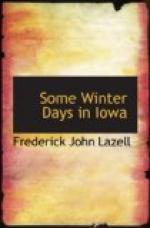One of the events of the day was the sight of the winter wren, the first time he had been seen this winter. He was working among the stumps of trees at the brink of the river, under the ice which had been left clinging to the trees when the high water receded. There was no mistaking his beautiful coat of cinnamon brown, his pert manner, his tail which was a little more than straight up, pointing towards his head; a little mite of a bird, how does he keep his little body from freezing in the furious winter storms? He seemed perfectly happy, with his two sharp, shrill, impatient “quip quaps,” much shriller than the “pleeks” of downy woodpecker.
A flock of tree sparrows were busy in and around a big thicket of wild gooseberry bushes on the upland. You may easily get within a rod of them, but hardly closer, and a field glass is almost a necessity to careful study. He is a grayish, graceful sparrow, with streaks of reddish brown, chestnut caps, and a small black spot in the middle of the brownish breast. One white wing bar is a distinguishing characteristic, and a better one is the difference in color of the two mandibles; the upper one is black and the lower one yellow. The tinkling notes of the tree sparrows sound like the music a pipe organist makes when he uses the sweet organ and the flute stop.
A sharp watch was kept for goldfinches and the evening grosbeak during the day, but neither was seen. This was something of a disappointment. But it was forgotten in the thrill of joy that came late in the afternoon. There was a wide stretch of river bottom, walled in on the west by a high and forest-crowned ridge; on the east was the river, with a hundred foot fringe of noble trees, not yet sacrificed to the axe of the woodsman. The sun was just above the tops of the trees on the western ridge and long rays of slanting light came pink across the river flood-plain, investing the tree-tops by the shore with a soft and radiant light. Suddenly there came a plaintive little note from the bottom of a near-by tree, instantly recognized as a new note in the winter woods. Then another, and another, leading the eyes to the foot of a big bass-wood, where a graceful bird, with a beautiful blue back and a reddish brown breast, as if his coat had been made of the bright blue sky and his vest of the shining red sand, was hopping. The field glass brought him within ten feet. A bluebird, sure enough! The first real, tangible sign of the spring that is to be, the first voice from the southland telling us that spring is coming up the valleys. There is no mistaking the brilliant blue, the most beautiful blue in the Iowa year, unless it be the blue of the fringed gentian in the fall; and the soft reddish, earthy breast enhances the beauty of the brilliant back.




